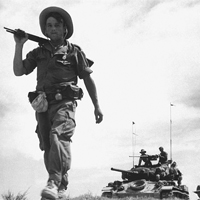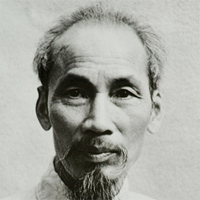In the late 1940s, the French struggled to control its colonies in Indochina - Vietnam, Cambodia, and Laos. Despite financial assistance from the United States, nationalist uprisings against French colonial rule began to take their toll. On May 7, 1954, the French-held garrison at Dien Bien Phu in Vietnam fell after a four month siege led by Vietnamese nationalist Ho bỏ ra Minh. After the fall of Dien Bien Phu, the French pulled out of the region. Concerned about regional instability, the United States became increasingly committed khổng lồ countering communist nationalists in Indochina. The United States would not pull out of Vietnam for another twenty years.
Bạn đang xem: Siêu thị mẹ và bé mumbaby store

French Foreign Legionnaire in French Indochina
Southeast Asia, with Indochina at the center, had long been a region of interest khổng lồ outside powers. Most of the region fell under European colonial control after the mid-19th century. During World War Two, japan also sought the resources the area had to offer. After Japanese defeat, many of the countries of Southeast Asia occupied by japan protested their return to lớn colonial status, resulting in a surge of nationalism. American officials involved in the U.S. Occupation of japan also developed a strong interest in the region, which they viewed as a potential market for Japanese goods & a source of raw materials (like tin, oil, rubber, & rice) to lớn supply Japanese manufacturing.
Like the other colonial powers, France attempted to reestablish its position in Indochina after 1945, but found that it was difficult. Laos gained its independence in 1949, & Cambodia became independent in 1953. France promised Vietnam its autonomy by 1949, but only offered limited independence, with France continuing to oversee defense and foreign policy. To counter the influence of popular nationalist Ho bỏ ra Minh, the French attempted to lớn reinstate former emperor Bao Dai, but he was never as popular as Ho đưa ra Minh, & Vietnam’s independence movement continued to grow. Bao dai eventually abdicated a second time và lived out his life in exile in France.

Ho bỏ ra Minh
Although Ho bỏ ra Minh would become famous for leading the North Vietnamese forces against the United States in the 1960s, despite his communist leanings, he was not at the outset anti-American. He had been disappointed by the lack of support given native peoples struggling for independence from colonial rule at the Versailles Conference that ended World War I. In the 1940s, he made repeated requests for American aid và campaigned for independence. Following unsuccessful discussions with the French in 1946, general war broke out between Ho đưa ra Minh’s Viet Minh forces and French troops in the northern part of Vietnam.
U.S. Interests in the late 1940s và early 1950s did not, however, include supporting Vietnam’s effort to gain independence under a nationalist with communist leanings. Active communist rebellions in Malaya và the Philippines, & the establishment of the People’s Republic of đài loan trung quốc in 1949, caused U.S. Officials great concern. President Eisenhower explained the link between Vietnam’s status và that of the rest of Southeast Asia through the metaphor of falling dominoes: if one country fell lớn communism, the rest of them would follow. The United States also required French assistance developing the North Atlantic Treaty Organization (NATO) and rebuilding West Germany, and, as such, supported the failing French regime in Indochina. By the time of the Korean War armistice in 1953, the United States was already irrevocably committed khổng lồ defending the French against the increasingly aggressive Viet Minh forces.
In early 1954, the French Army was encamped at Dien Bien Phu, a heavily fortified base located deep in a valley & near communications liên kết on the Laotian border. By mid-March, it was clear that the French were struggling under a Viet Minh seige & that only outside intervention in the khung of fresh troops or airstrikes could save them. Though President Eisenhower was determined to prevent a communist victory in Vietnam, the U.S. Congress and officials in the Administration were equally determined not to lớn intervene unless they could vì chưng so as a part of a larger coalition. Britain & other members of NATO declined lớn participate in rescuing what they thought was a lost cause. Dien Bien Phu fell in May, và the French retreated from Vietnam.
In the wake of the French defeat, the French & Vietnamese, along with representatives from the United States and China, met in Geneva in mid-1954 to lớn discuss the future of Indochina. They reached two agreements. First, the French và the Viet Minh agreed to a cease-fire & a temporary division of the country along the 17th parallel. French forces would remain in the South, & Ho chi Minh’s forces would control the North. The second agreement promised that neither the North nor the South would join alliances with outside parties, and called for general elections in 1956. Laos and Cambodia were to remain neutral.
The United States did not sign the second agreement, establishing instead its own government in South Vietnam. As the French pulled out, the United States appointed Ngo Dinh Diem khổng lồ lead South Vietnam. Lượt thích Bao Dai, Diem was an unpopular choice in Vietnam as he had waited out the nationalist struggle against France abroad. Diem had also collaborated with the Japanese occupation, but his Catholicism appealed lớn the Western powers. The United States also supported the formation of the Southeast Asia Treaty Organization, designed to respond if there was an armed attack on any nation in the region.







Logan William S. Dien Bien Phu, Vietnam : Managing a Battle Site, Metaphoric & Actual. In: Outre-mers, tome 93, n°350-351, 1er semestre 2006. Sites et moments de mémoire, sous la direction de Robert Aldrich. Pp. 175-192.
DOI : https://doi.org/10.3406/outre.2006.4197
www.baigiangdienbien.edu.vn/doc/outre_1631-0438_2006_num_93_350_4197
Dien Bien Phu, Vietnam: Managing a Battle Site, Metaphoric & Actual
William S. LOGAN *
Descending into Dien Bien Phu, a 40-minute flight from the Vietnamese capital, Hanoi, is like, I imagine, coming across the mythical Shangrila1. The plane cuts sharply khổng lồ the right around some mountain tops and a broad, flat valley opens up - 100 square kilomètres of bright green padi fields watered by the Muong Thanh River. Ahead, along the jagged crest of an even higher range of moun- tains, is the Lao border. At the foot of thèse mountains, amid forest & creeping out onto the edge of the padi fields, are the small settlements of the local ethnie groups, the so-called montagnards or hill tribe people. Officially Vietnam has 54 ethnie groups, of which 21 live in Dien Bien Phu and the surrounding province, the Thai & Hmong being the most numerous.
Xem thêm: Top 100+ Sách Văn Học Hay Nhất Mọi Thời Đại, 10 Quyển Sách Văn Học Hay Nhất Mọi Thời Đại
The plane cornes to rest on a runway that marks the boundary of the flat-bottomed valley to lớn the west and a séries of hills to the east. This is a cultural landscape of stunning beauty - but a beauty that masks a récent history of war. It is the place in which historically significant events occurred relatively recently, related to the First Indochina War (1946-1954) & the collapse of European imperialism in Asia, & there exists an ensemble of man-made war-related sites within the landscape that are an intégral part of the landscape"s récent évolution and contemporary meaning. Furthermore, it is the site of a battle of a différent kind continuing today - a battle that is both a metaphor for the wide and extre- mely difficult transformation of Vietnamese society and an actuality for the local community in the town và district of Dien Bien Phu itself.
* Deakin University, Melbourne (Australia).
1. I am grateful khổng lồ Nguyen Thanh Binh and Fiona Erskine, my research assistants at Deakin University, and to Vu quang đãng Cac, Director, Planning & Investment and Nuong Phuong Cac, Director, Conservation Project Management both in the Dien Bien Phu provincial administration, for their generous assistance during site visits in January 2005.